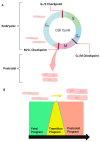Regulatory Mechanisms That Guide the Fetal to Postnatal Transition of Cardiomyocytes
- PMID: 37759546
- PMCID: PMC10528641
- DOI: 10.3390/cells12182324
Regulatory Mechanisms That Guide the Fetal to Postnatal Transition of Cardiomyocytes
Abstract
Heart disease remains a global leading cause of death and disability, necessitating a comprehensive understanding of the heart's development, repair, and dysfunction. This review surveys recent discoveries that explore the developmental transition of proliferative fetal cardiomyocytes into hypertrophic postnatal cardiomyocytes, a process yet to be well-defined. This transition is key to the heart's growth and has promising therapeutic potential, particularly for congenital or acquired heart damage, such as myocardial infarctions. Although significant progress has been made, much work is needed to unravel the complex interplay of signaling pathways that regulate cardiomyocyte proliferation and hypertrophy. This review provides a detailed perspective for future research directions aimed at the potential therapeutic harnessing of the perinatal heart transitions.
Keywords: fetal to postnatal development; hypertrophy and proliferation; micro-RNA; signaling pathways (mTOR, Hippo, YAP/TAZ); therapeutic potential.
Conflict of interest statement
The authors declare no conflict of interest.
Figures


Similar articles
-
MicroRNA205: A Key Regulator of Cardiomyocyte Transition from Proliferative to Hypertrophic Growth in the Neonatal Heart.Int J Mol Sci. 2024 Feb 12;25(4):2206. doi: 10.3390/ijms25042206. Int J Mol Sci. 2024. PMID: 38396885 Free PMC article.
-
miR-206 Mediates YAP-Induced Cardiac Hypertrophy and Survival.Circ Res. 2015 Oct 23;117(10):891-904. doi: 10.1161/CIRCRESAHA.115.306624. Epub 2015 Sep 2. Circ Res. 2015. PMID: 26333362 Free PMC article.
-
Long Noncoding RNA CPR (Cardiomyocyte Proliferation Regulator) Regulates Cardiomyocyte Proliferation and Cardiac Repair.Circulation. 2019 Jun 4;139(23):2668-2684. doi: 10.1161/CIRCULATIONAHA.118.035832. Epub 2019 Mar 5. Circulation. 2019. PMID: 30832495
-
Upstream regulation of the Hippo-Yap pathway in cardiomyocyte regeneration.Semin Cell Dev Biol. 2020 Apr;100:11-19. doi: 10.1016/j.semcdb.2019.09.004. Epub 2019 Oct 9. Semin Cell Dev Biol. 2020. PMID: 31606277 Free PMC article. Review.
-
Harnessing developmental cues for cardiomyocyte production.Development. 2023 Aug 1;150(15):dev201483. doi: 10.1242/dev.201483. Epub 2023 Aug 10. Development. 2023. PMID: 37560977 Free PMC article. Review.
Cited by
-
Recent Insights into Endogenous Mammalian Cardiac Regeneration Post-Myocardial Infarction.Int J Mol Sci. 2024 Nov 1;25(21):11747. doi: 10.3390/ijms252111747. Int J Mol Sci. 2024. PMID: 39519298 Free PMC article. Review.
-
MicroRNA205: A Key Regulator of Cardiomyocyte Transition from Proliferative to Hypertrophic Growth in the Neonatal Heart.Int J Mol Sci. 2024 Feb 12;25(4):2206. doi: 10.3390/ijms25042206. Int J Mol Sci. 2024. PMID: 38396885 Free PMC article.
References
-
- Lozano R., Naghavi M., Foreman K., Lim S., Shibuya K., Aboyans V., Abraham J., Adair T., Aggarwal R., Ahn S.Y., et al. Global and regional mortality from 235 causes of death for 20 age groups in 1990 and 2010: A systematic analysis for the Global Burden of Disease Study 2010. Lancet. 2012;380:2095–2128. doi: 10.1016/S0140-6736(12)61728-0. - DOI - PMC - PubMed
-
- Perin E.C., Willerson J.T., Pepine C.J., Henry T.D., Ellis S.G., Zhao D.X., Silva G.V., Lai D., Thomas J.D., Kronenberg M.W., et al. Effect of transendocardial delivery of autologous bone marrow mononuclear cells on functional capacity, left ventricular function, and perfusion in chronic heart failure: The FOCUS-CCTRN trial. JAMA. 2012;307:1717–1726. doi: 10.1001/jama.2012.418. - DOI - PMC - PubMed
-
- Mathiasen A.B., Qayyum A.A., Jørgensen E., Helqvist S., Kofoed K.F., Haack-Sørensen M., Ekblond A., Kastrup J. Bone marrow-derived mesenchymal stromal cell treatment in patients with ischaemic heart failure: Final 4-year follow-up of the MSC-HF trial. Eur. J. Heart Fail. 2020;22:884–892. doi: 10.1002/ejhf.1700. - DOI - PubMed
Publication types
MeSH terms
Grants and funding
LinkOut - more resources
Full Text Sources
Medical
Miscellaneous

